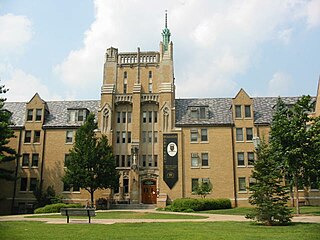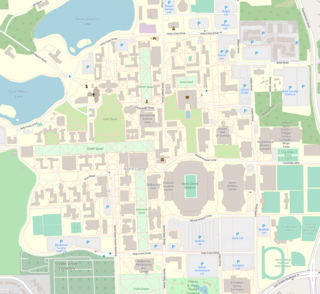
The University of Notre Dame du Lac is a private Catholic research university in Notre Dame, Indiana, United States. Founded in 1842 by members of the clerical Congregation of Holy Cross, the main campus of 1,261 acres has a suburban setting and contains landmarks such as the Golden Dome, the Word of Life mural, Notre Dame Stadium, and the basilica.

Theodore Martin Hesburgh, CSC was an American Catholic priest and academic who was a member of the Congregation of Holy Cross. He is best known for his service as president of the University of Notre Dame for thirty-five years (1952–1987).

Notre Dame Stadium is an outdoor football stadium in Notre Dame, Indiana, the home field of the University of Notre Dame Fighting Irish football team.

The Joyce Center, formerly the Athletic & Convocation Center, is a 9,149-seat multi-purpose arena in Notre Dame, Indiana just north of South Bend. The arena opened its doors in 1968. It is home to the University of Notre Dame Fighting Irish basketball and volleyball teams. The main arena, Phillip J. Purcell Pavilion, is located in the southern portion of the facility. The northern portion housed a hockey rink until October 2011. It is also home to the Castellan Family Fencing Center and Rolfs Aquatic Center in the rear of the building.

Hanner Fieldhouse is a 4,325-seat multi-purpose arena in Statesboro in the U.S. state of Georgia. It was built in 1969 and is home to the Georgia Southern University men's basketball, women's basketball and women's volleyball teams. It hosted the 1985 and 1992 Atlantic Sun Conference men's basketball tournaments.
Ellerbe Becket was an independent Minneapolis, Minnesota-based architectural, engineering, interior design and construction firm until 2009, when it was acquired by AECOM.

Hinkle Fieldhouse is a basketball arena on the campus of Butler University in Indianapolis, Indiana. Completed in early 1928, it was the largest basketball arena in the United States until 1950. The facility was renamed Hinkle Fieldhouse in 1966 in honor of Butler's longtime coach and athletic director, Paul D. "Tony" Hinkle. It is the sixth-oldest college basketball arena still in use. Added to the National Register of Historic Places in 1983 and designated a U.S. National Historic Landmark in 1987, Hinkle Fieldhouse is sometimes referred to as "Indiana's Basketball Cathedral."
The Theodore Roosevelt Award is the highest honor the National Collegiate Athletic Association (NCAA) may confer on an individual. The award is awarded annually to a graduate from an NCAA member institution who earned a varsity letter in college for participation in intercollegiate athletics, and who ultimately became a distinguished citizen of national reputation based on outstanding life accomplishment. Each awardee, by personal example, is said to exemplify the ideals and purposes to which collegiate athletics are dedicated.

Badin Hall is one of the 32 Residence Halls on the campus of the University of Notre Dame and one of the 14 female dorms. The smallest residence hall on campus, it is located on South Quad, between Howard Hall and the Coleman-Morse center. It was built in 1897 and hosted the Manual Labor School until 1917 before being converted into a men's dorm. During World War II, it was part of the United States Naval Reserve Midshipmen's School, and in 1972 it became one of the first two residence halls at Notre Dame to host women.

The University of Notre Dame School of Architecture was the first Catholic university in America to offer a degree in architecture, beginning in 1898. The School offers undergraduate and post-graduate architecture programs.
There are currently 32 undergraduate residence halls at the University of Notre Dame, including 31 active residence halls and Zahm Hall, which serves as a transition dorm when residence halls undergo construction. Several of the halls are historic buildings which are listed on the National Register of Historic Places. Each residence hall is single-sex, with 17 all-male residence halls and 15 all-female residence halls. Notre Dame residence halls feature a mixed residential college and house system, where residence halls are the center of the student life and some academic teaching; most students stay at the same hall for most of their undergraduate studies. Each hall has its own traditions, events, mascot, sports teams, shield, motto, and dorm pride. The university also hosts Old College, an undergraduate residence for students preparing for the priesthood.

Theodore Hesburgh Library is the primary building of the University of Notre Dame's library system. The present-day building opened on September 18, 1963, as Memorial Library. In 1987, it was renamed Hesburgh Library, in honor of Rev. Theodore Hesburgh, C.S.C., who served as the university's president from 1952 to 1987. The library's exterior façade that faces the university's football stadium includes a large, 134-foot (41 m) by 68-foot (21 m) mural called Word of Life, or more commonly known as Touchdown Jesus. As of 2009, the library ranked as the 61st largest collection among research universities in the United States, with an estimated 3.39 million volumes.

The Notre Dame Fighting Irish baseball team is the intercollegiate baseball team representing the University of Notre Dame in Notre Dame, Indiana. Notre Dame competes as a member of the Atlantic Coast Conference in the NCAA Division 1 college baseball league. The team is currently coached by Shawn Stiffler and plays its home games at Frank Eck Baseball Stadium, which has a capacity of 1,825. The school has appeared in three College World Series, in 1957, 2002, and 2022 and has won 6 conference titles.

The University of Notre Dame was founded on November 26, 1842, by Father Edward Sorin, CSC, who was also its first president, as an all-male institution on land donated by the Bishop of Vincennes. Today, many Holy Cross priests continue to work for the university, including as its president. Notre Dame rose to national prominence in the early 1900s for its Fighting Irish football team, especially under the guidance of the legendary coach Knute Rockne. Major improvements to the university occurred during the administration of Rev. Theodore Hesburgh between 1952 and 1987 as Hesburgh's administration greatly increased the university's resources, academic programs, and reputation and first enrolled women undergraduates in 1972.

Morrissey Hall is one of the 32 Residence Halls on the campus of the University of Notre Dame and one of the 16 male dorms. Built in 1925-1926, its architects were Vincent Fagan and Francis Kervick. Along with other buildings on Notre Dame's campus, it is on the National Register of Historic Places. It is referred to as Morrissey Manor by its residents.

The campus of the University of Notre Dame is located in Notre Dame, Indiana, and spans 1,250 acres (510 ha) comprising around 190 buildings. The campus is consistently ranked and admired as one of the most beautiful university campuses in the United States and around the world. It is particularly noted for the Golden Dome, the Basilica and its stained glass windows, the quads and the greenery, the Grotto, Touchdown Jesus, its collegiate Gothic architecture, and its statues and museums. Notre Dame is a major tourist attraction in northern Indiana; in the 2015–2016 academic year, more than 1.8 million visitors, almost half of whom were from outside of St. Joseph County, visited the campus.

Christ and the Samaritan Woman is an outdoor sculpture by Croatian sculptor Ivan Meštrović. Created in 1957, the sculpture resides in front of O’Shaughnessy Hall on the campus of the University of Notre Dame as part of the Shaheen-Mestrovic Memorial, which was completed in 1985 by the Department of Landscape Architecture and Planning in the South Bend office of Cole Associates. The marble and bronze sculpture depicts the events in John 4, in which Jesus converses and evangelizes to a woman from Samaria, with whom the Jews would not normally associate. Eli J. Shaheen, a Notre Dame alum, was the donor for the project, which is owned by the university. The “Woman at the Well,” as it is often referred, is flanked by sculptures of the gospel writers Luke the Evangelist and John the Evangelist. It has been regarded as the most notable and celebrated of Meštrović's works from his period at Notre Dame.

Fathers Theodore Hesburgh and Edmund Joyce is an outdoor statue on the University of Notre Dame campus. Located on the South side of the Hesburgh Library facing the reflecting pool, the sculpture was designed and built by artist Lou Cella, a member of the Rotblatt-Amrany Fine Art Studio, and is currently owned by the University of Notre Dame.

The Clarke Memorial Fountain is a large public fountain on the campus of the University of Notre Dame in Notre Dame, Indiana, United States.

Breen-Phillips hall is one of the 32 Residence Halls on the campus of the University of Notre Dame and one of the 14 female dorms. Breen-Phillips is on North Quad, between Farley Hall, Geddes Hall, and the Hesburgh Library. Established in 1939, it hosts 200 students.


















